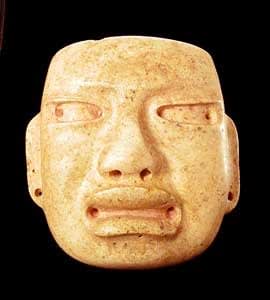Olmec Stone Mask, 900 BCE - 500 BCE
Stone
6.5 x 6.5 x 2.5
PF.5534
In the Olmec culture the mask was considered an icon of transformation. It makes visible the charismatic and shamanic power of the wearer; who was either a ruler or shaman....
In the Olmec culture the mask was considered an icon of transformation. It makes visible the charismatic and shamanic power of the wearer; who was either a ruler or shaman. Often the mask has an expression of an otherworldly nature, as if submerged in an ecstatic trance. A mask will never change, it is unaffected by emotion or time, and will forever express the virtues the sculptor endowed upon it. This quality of the eternal appealed to Olmec rulers. The sheer power of this stone mask is monumental in scope. There is a sense it is a product of nature, elemental and beyond comprehension. Yet, a very skilled sculptor was needed to carve the intricate designs. This is not difficult to imagine given its almost primordial character, which seems to come from another dimension. In many respects the Olmec themselves seem not to have been of this world; and objects such as this extraordinary mask appear as living proof. Today, masks are worn mostly for the fun of Halloween parties or the profit of robbing banks. In either case their purpose is simply to conceal the identity of the wearer. The peoples of ancient cultures, however, believed that masks were magical and that by donning one the wearer actually became the god, demon or animal it represented and was, therefore, endowed with all its powers of good or evil. Masks of every conceivable non-perishable material and varying sizes have been found all over Mexico. The earliest we know of were made of clay but it is probable that others made of gourds or even paper have not survived. Jade, as the symbol of life and the most precious substance known, was often used for the most prestigious kings and powerful gods. Masks were frequently laid over the faces or on the chests of the dead. Though their actual purpose is obscure, at least one, that found in the tomb of a Pakal, ruler of Palenque, seems to have been a true portrait of the deceased.
